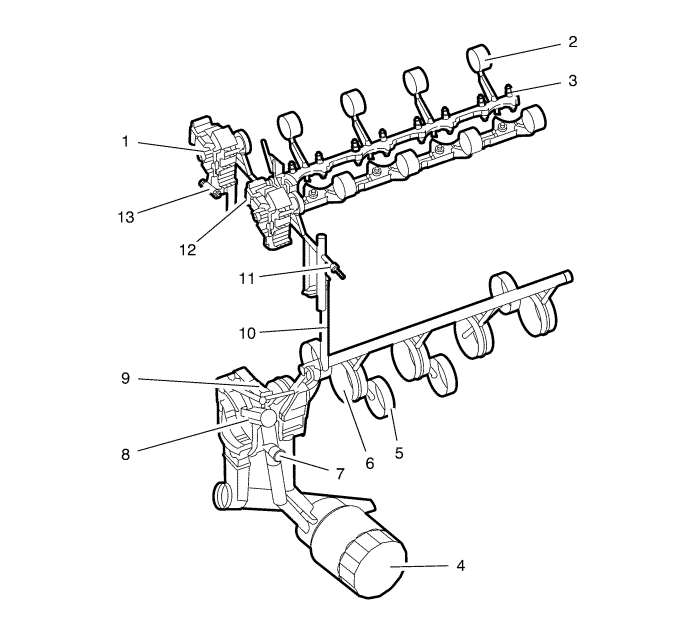Volt |
||||||||
|
|
|
|||||||

Oil is applied under pressure to the crankshaft bearings (6), connecting rod bearings (5), camshaft bearings (2) and hydraulic clearance adjusters (3). In addition, the variable oil pump (8), variable camshaft phaser (1), and hydraulic chain tensioner (13) are supplied with pressurised oil. Oil is sucked from the oil sump through the fixed screen into the variable vane type oil pump. The pump is integrated in the front cover and directly driven by the crankshaft. Also integrated into the front cover is a pressure relieve valve (7) that opens when the oil pressure is too high at a cold start. When that valve is open some oil flows directly into the oil sump. Normally the pressurised oil passes into the engine oil gallery leading to the oil filter (4). The oil is cleaned by passing the filter from the outer to the inner side of the filter. Then the oil flows into the main oil gallery. A filter by-pass valve in the oil filter ensures continuous oil flow in case the oil filter should be restricted by more than 1.7 bar. From the oil filter the oil is distributed to the crankshaft bearings, oil pump displacement control chamber (9) and cylinder head feed (10). The connecting rod bearings are supplied by oil flow passages through the crankshaft connecting the main journals to the rod journals. A groove around each upper main bearing furnishes oil to the drilled crankshaft passages. In the cylinder head the oil is distributed to the variable camshaft phasers, chain tensioner, oil pressure switch (11) and through the restrictor orifice (12) into the camshaft feed oil gallery. From there the hydraulic tappets and camshaft bearings are supplied with oil.
The engine is equipped with a variable displacement vane oil pump. It is indirectly regulated by the oil pressure out of the main oil gallery. The purpose of this indirect regulation is to keep a defined maximum pressure in the main oil gallery independently of the individual pressure drop between the pump outlet and the main gallery inlet and the individual oil flow to the consumers (bearing clearances differ, wear differs, [mldr ]) The purpose of the variable displacement is to reduce the power consumption of the pump to reduce the overall fuel consumption of the engine. The oil flow of a static displacement oil pump is linear to the speed of the pump. This would lead to a too high oil pressure after a certain engine speed (approx. 1000 rpm at cold oil temperature, approx. 3000 rpm at hot oil temperatures). To reduce that high oil pressure, normal pumps have a relieve valve: a portion of the pressurised, already pumped oil is fed back to the intake of the pump. This is waste of power. The oil flow of a Variable Displacement Vane Pump (VDVP) as used in Fam 0 Gen 3 is linear to the speed and to the eccentricity of the rotor to the slide. The slide is movable, so it is possible to reduce the oil flow for a given speed by reducing the eccentricity. With a lower flow the oil pressure is reduced; pump oil flow now equals engine oil flow.
| © Copyright Chevrolet. All rights reserved |